Unique and complementary suppression of cGAS-STING and RNA sensing- triggered innate immune responses by SARS-CoV-2 proteins
- PMID: 33723219
- PMCID: PMC7958565
- DOI: 10.1038/s41392-021-00515-5
Unique and complementary suppression of cGAS-STING and RNA sensing- triggered innate immune responses by SARS-CoV-2 proteins
Abstract
The emergence of SARS-CoV-2 has resulted in the COVID-19 pandemic, leading to millions of infections and hundreds of thousands of human deaths. The efficient replication and population spread of SARS-CoV-2 indicates an effective evasion of human innate immune responses, although the viral proteins responsible for this immune evasion are not clear. In this study, we identified SARS-CoV-2 structural proteins, accessory proteins, and the main viral protease as potent inhibitors of host innate immune responses of distinct pathways. In particular, the main viral protease was a potent inhibitor of both the RLR and cGAS-STING pathways. Viral accessory protein ORF3a had the unique ability to inhibit STING, but not the RLR response. On the other hand, structural protein N was a unique RLR inhibitor. ORF3a bound STING in a unique fashion and blocked the nuclear accumulation of p65 to inhibit nuclear factor-κB signaling. 3CL of SARS-CoV-2 inhibited K63-ubiquitin modification of STING to disrupt the assembly of the STING functional complex and downstream signaling. Diverse vertebrate STINGs, including those from humans, mice, and chickens, could be inhibited by ORF3a and 3CL of SARS-CoV-2. The existence of more effective innate immune suppressors in pathogenic coronaviruses may allow them to replicate more efficiently in vivo. Since evasion of host innate immune responses is essential for the survival of all viruses, our study provides insights into the design of therapeutic agents against SARS-CoV-2.
Conflict of interest statement
The authors declare no competing interests.
Figures
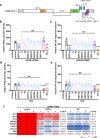
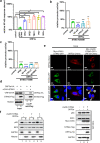
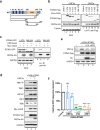
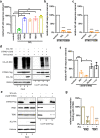
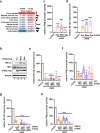
Similar articles
-
SARS-CoV-2 ORF3a inhibits cGAS-STING-mediated autophagy flux and antiviral function.J Med Virol. 2023 Jan;95(1):e28175. doi: 10.1002/jmv.28175. Epub 2022 Oct 8. J Med Virol. 2023. PMID: 36163413 Free PMC article.
-
Sensing of cytoplasmic chromatin by cGAS activates innate immune response in SARS-CoV-2 infection.Signal Transduct Target Ther. 2021 Nov 3;6(1):382. doi: 10.1038/s41392-021-00800-3. Signal Transduct Target Ther. 2021. PMID: 34732709 Free PMC article.
-
HIV-1 Vpu and SARS-CoV-2 ORF3a proteins disrupt STING-mediated activation of antiviral NF-κB signaling.Sci Signal. 2025 Jan 21;18(870):eadd6593. doi: 10.1126/scisignal.add6593. Epub 2025 Jan 21. Sci Signal. 2025. PMID: 39836751
-
How Dengue Virus Circumvents Innate Immunity.Front Immunol. 2018 Dec 4;9:2860. doi: 10.3389/fimmu.2018.02860. eCollection 2018. Front Immunol. 2018. PMID: 30564245 Free PMC article. Review.
-
Progress of cGAS-STING signaling in response to SARS-CoV-2 infection.Front Immunol. 2022 Dec 7;13:1010911. doi: 10.3389/fimmu.2022.1010911. eCollection 2022. Front Immunol. 2022. PMID: 36569852 Free PMC article. Review.
Cited by
-
TRAF3 activates STING-mediated suppression of EV-A71 and target of viral evasion.Signal Transduct Target Ther. 2023 Feb 24;8(1):79. doi: 10.1038/s41392-022-01287-2. Signal Transduct Target Ther. 2023. PMID: 36823147 Free PMC article.
-
Innate Receptors Expression by Lung Nociceptors: Impact on COVID-19 and Aging.Front Immunol. 2021 Dec 16;12:785355. doi: 10.3389/fimmu.2021.785355. eCollection 2021. Front Immunol. 2021. PMID: 34975876 Free PMC article. Review.
-
DNA virus oncoprotein HPV18 E7 selectively antagonizes cGAS-STING-triggered innate immune activation.J Med Virol. 2023 Jan;95(1):e28310. doi: 10.1002/jmv.28310. Epub 2022 Nov 21. J Med Virol. 2023. PMID: 36377393 Free PMC article.
-
Long COVID: current status in Japan and knowledge about its molecular background.Glob Health Med. 2022 Apr 30;4(2):83-93. doi: 10.35772/ghm.2022.01013. Glob Health Med. 2022. PMID: 35586759 Free PMC article. Review.
-
Human Cytomegalovirus UL138 Protein Inhibits the STING Pathway and Reduces Interferon Beta mRNA Accumulation during Lytic and Latent Infections.mBio. 2021 Dec 21;12(6):e0226721. doi: 10.1128/mBio.02267-21. Epub 2021 Dec 14. mBio. 2021. PMID: 34903048 Free PMC article.
References
Publication types
MeSH terms
Substances
Grants and funding
LinkOut - more resources
Full Text Sources
Other Literature Sources
Molecular Biology Databases
Research Materials
Miscellaneous

